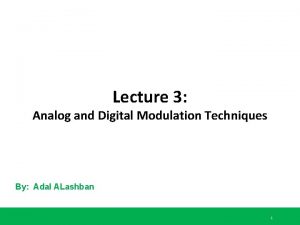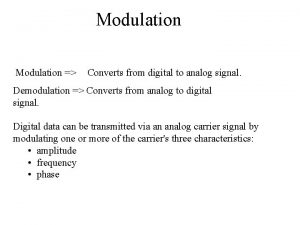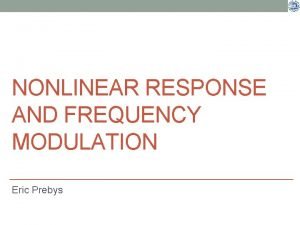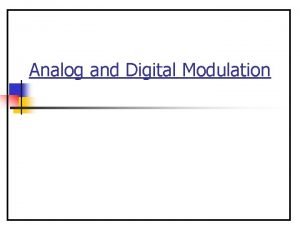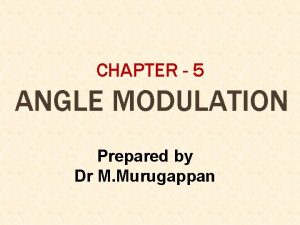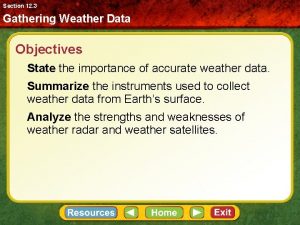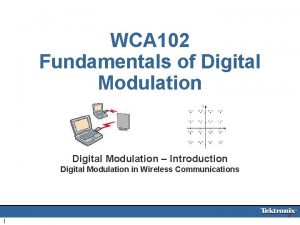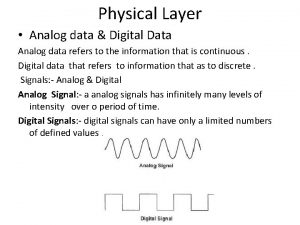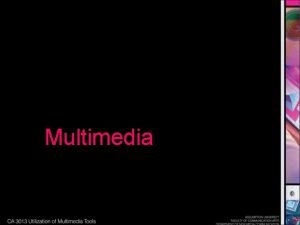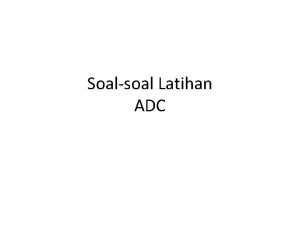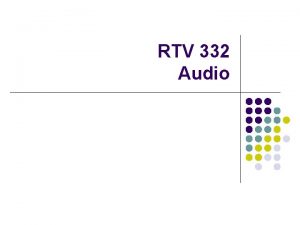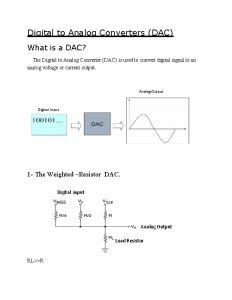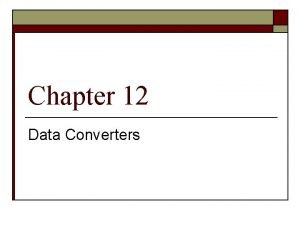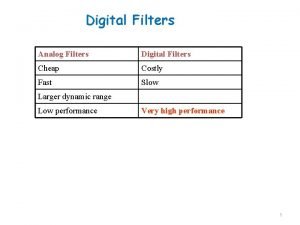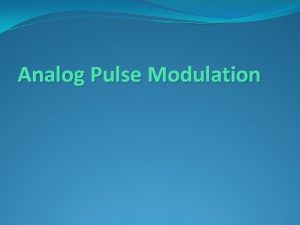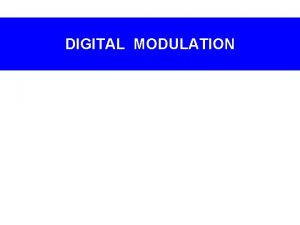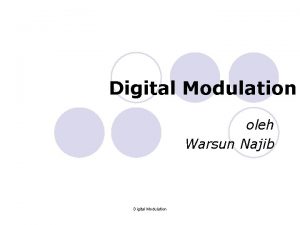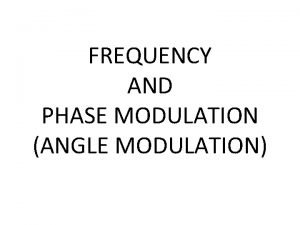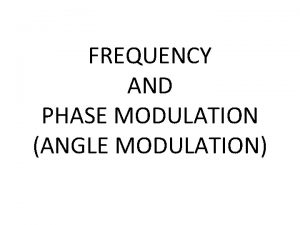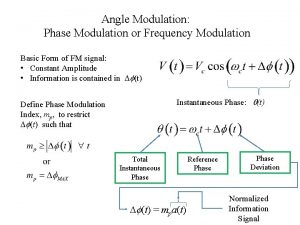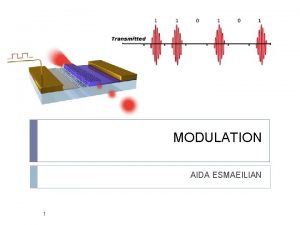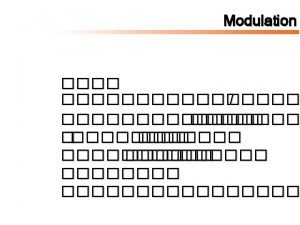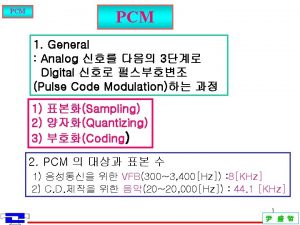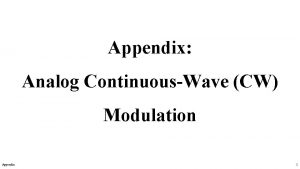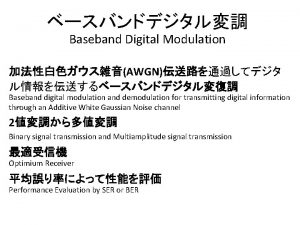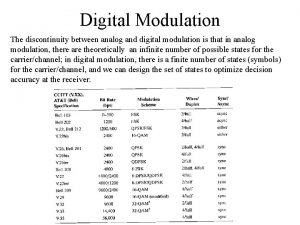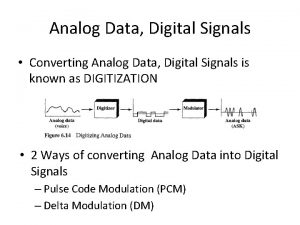Lecture 1 28 Analog and digital modulation and








































- Slides: 40

Lecture 1. 28 Analog and digital modulation and demodulation of signals

Signal Encoding Techniques (modulation and encoding) q. Analog data to analog signal (AM, FM, PM) q. Digital data to analog signal (ASK, FSK, BPSK, QAM) q. Analog data to digital signal (PCM, DM) q. Digital data to digital signal (line codes) 2

Analog Signals 3

Digital Signals 4

Analog and Digital Transmission

Analog and Digital Transmission

Modulation n n The process by which some characteristics of a carrier wave is varied in accordance with an information-bearing signal. Continuous-wave modulation n Amplitude modulation n Frequency modulation

AMPLITUDE MODULATION 8

AM modulation family Amplitude modulation (AM) n Double sideband-suppressed carrier (DSBSC) n Single sideband (SSB) n Vestigial sideband (VSB, analog TV) n

AMPLITUDE MODULATION Carrier wave: is a waveform (usually sinusoidal) that is modulated (modified) with an input signal for the purpose of conveying information. This carrier wave is usually a much higher frequency than the input signal. 1. n 2. DEFINING AM A carrier wave whose amplitude is varied in proportion to the instantaneous amplitude of a modulating voltage GENERATING THE AM nonlinear device: diode or transistor biased in its nonlinear region

DCTC, By Ya Bao 11

ANALYSIS OF THE AM WAVE 12

13

Different Carriers and AM Carriers are spaced at 20 k. Hz, beginning at 1000 k. Hz. Each carrier is modulated by a signal with 5 k. Hz bandwidth. Is there interference from sideband overlap? 14

MODULATION INDEX AND SIGNAL POWER 15

Moduiation Index and Power 16

Current Calculations Example A carrier of 1000 W is modulated with a resulting modulation index of 0. 8. What is the total power? What is the carrier power if the total power is 1000 W and the modulation index is 0. 95? 17

Double Sideband Suppressed Carrier (DSBSC) When the carrier is reduced, this is called doublesideband suppressed-carrier AM, or DSB-SC. If the carrier could somehow be removed or reduced, the transmitted signal would consist of two informationbearing sidebands, and the total transmitted power would be information 18

Single-Sideband (SSB) suppressing the carrier and one of the sidebands 19

20

Filtering the SSB ( LSB or USB ) Dual Conversion: up-converting the modulating frequency twice and selecting the upper or lower sideband for transmission. 21

AM: Features and Drawbacks: Øthe AM signal is greatly affected by noise Øimpossible to determine absolutely the original signal level Øconventional AM is not efficient in the use of transmitter power ØAM is useful where a simple, low-cost receiver and detector is desired 22

Angle Modulation 23

Angle Modulation The modulating signal can be conveyed by varying the frequency or phase of the carrier signal. When this is the case, we have angle modulation, which can be subdivided into two categories: 1. Frequency modulation (FM) 2. Phase modulation (PM). 24

Frequency Modulation. The carrier's instantaneous frequency deviation from its unmodulated value varies in proportion to the instantaneous amplitude of the modulating signal. Phase Modulation. The carrier's instantaneous phase deviation from its unmodulated value varies as a function of the instantaneous amplitude of the modulating signal; 25

The FM and PM waveforms for sine-wave modulation: (a) carrier wave; (b) modulation wave; (c) FM wave; (d) PM wave. (Note: The derivative of the modulating sine wave is the cosine wave shown by the dotted lines. The PM wave appears to be frequency modulated by the cosine wave. ) 26

MODULATION INDEX modulation index for an FM signal δ = maximum frequency deviation of the carrier caused by the amplitude of the modulating signal fm = frequency of the modulating signal 27

FREQUENCY ANALYSIS OF THE FM WAVE where: e. Fm = the instantaneous amplitude of the modulated FM wave Ac = the peak amplitude of the carrier Jn = solution to the nth order Bessel function for a modulation index mf. mf = FM modulation index, Δf/fm 28

29

Spectral components of a carrier of frequency, fc, frequency modulated by a sine wave with frequency fm 30

FM signal characters • The FM wave is comprised of an infinite number of sideband components • bandwidth of an FM signal must be wider than that of an AM signal • As the modulation index increases from mf = 0, the spectral energy shifts from the carrier frequency to an increasing number of significant sidebands. • Jn(mf) coefficients, decrease in value with increasing order, n. • negative Jn(mf) coefficients imply a 1800 phase inversion. 31

Bandwidth Requirements for FM The higher the modulation index, the greater the required system bandwidth where n is the highest number of significant (least 1%, or -40 d. B; (20 log 1/100 ), of the voltage of the unmodulated carrier) sideband components and fm is the highest modulation frequency. Carson's Rule 32

Amplitude versus frequency spectrum for various modulation indices (f m fixed, & varying): (a) mf = 0. 25; (b) mf = 1; (c) mf = 2; (d) mf = 5; (e) mf = 10. 33

Warren Hioki Telecommunications, Fourth Edition Copyright © 2001 by Prentice-Hall, Inc. Upper Saddle River, New Jersey 07458 All rights reserved. 34

Commercial FM broadcast band 35

Commercial FM broadcast band • The maximum permissible carrier deviation, δ, is ± 75 k. Hz • Modulating frequencies (voice or music) is ranging from 50 Hz to 15 k. Hz • The modulation index can range from as low as 5 for fm = 15 k. Hz (75 k. Hz/15 k. Hz) to as high as 1500 for fm = 50 Hz (75 k. Hz/50 Hz). • The ± 75 -k. Hz carrier deviation results in an FM bandwidth requirement of 150 k. Hz for the receiver. • A 25 -k. Hz guard band above and below the upper and lower FM sidebands. • Total bandwidth of one channel is 200 Hz. 36

Narrowband FM (NBFM) NBFM uses low modulation index values, with a much smaller range of modulation index across all values of the modulating signal. An NBFM system restricts the modulating signal to the minimum acceptable value, which is 300 Hz to 3 KHz for intelligible voice. 10 to 15 k. Hz of spectrum. Used in police, fire, and Taxi radios, GSM, amateur radio, etc. 37

POWER IN THE FM WAVE power of the unmodulated carrier For a modulated carrier 38

FM NOISE Increased bandwidth of an FM – to enhance the signal-tonoise ratio (SNR). Advantages of FM over AM. To take this advantage, large mf is necessary– high order sidebands are important – wider bandwidth is required. Phase Analysis of FM Noise where α = the maximum phase deviation of the carrier frequency caused by the noise VN = noise voltage Vc= carrier voltage 39

• The effect of noise on an FM carrier signal is directly proportional to the modulation frequency fm. • Increasing fm, degrades the Voice, data, and music contain many frequencies, which are distributed throughout the given modulation passband. Therefore, the SNR is not uniform throughout. To maintain a flat SNR, some techniques are employed. 40
 Analog and digital modulation techniques
Analog and digital modulation techniques Modulation digital to analog
Modulation digital to analog Amplitude modulation vs frequency modulation
Amplitude modulation vs frequency modulation Wave modulation
Wave modulation Advantages of angle modulation over amplitude modulation
Advantages of angle modulation over amplitude modulation Thermal noise in analog communication
Thermal noise in analog communication Compare and contrast analog and digital forecasting
Compare and contrast analog and digital forecasting Compare and contrast analog and digital forecasting
Compare and contrast analog and digital forecasting Advantages of digital modulation
Advantages of digital modulation Digital transmission advantages and disadvantages
Digital transmission advantages and disadvantages Analog and digital video in multimedia
Analog and digital video in multimedia Digital vs analog video
Digital vs analog video Analog digital transmission
Analog digital transmission Analog image and digital image
Analog image and digital image Analog and digital signals in computer networking
Analog and digital signals in computer networking Vhmax
Vhmax Digital and analog quantities
Digital and analog quantities Introduction to digital control system
Introduction to digital control system Analog and digital video in multimedia
Analog and digital video in multimedia Analog signla
Analog signla Compare analog and digital filters
Compare analog and digital filters Introduction to digital control system
Introduction to digital control system Razavi cmos analog circuit design
Razavi cmos analog circuit design 01:640:244 lecture notes - lecture 15: plat, idah, farad
01:640:244 lecture notes - lecture 15: plat, idah, farad Pengertian teknologi digital dan analog
Pengertian teknologi digital dan analog Analog vs digital
Analog vs digital Amw huebsch
Amw huebsch Advantages and disadvantages of flash adc
Advantages and disadvantages of flash adc Analog to digital converter
Analog to digital converter Kepanjangan adc
Kepanjangan adc Rumus adc
Rumus adc Digital vs analog sound
Digital vs analog sound Digital signal as a composite analog signal
Digital signal as a composite analog signal Analog vs digital communication systems
Analog vs digital communication systems Taufal
Taufal Digital to analog converter
Digital to analog converter Digital to analog converters basic concepts
Digital to analog converters basic concepts Digital to analog conversion in data communication
Digital to analog conversion in data communication Analog encoding
Analog encoding Tap digital
Tap digital Analog vs digital
Analog vs digital
